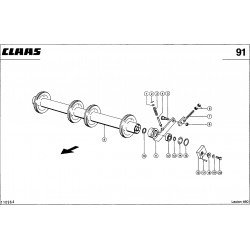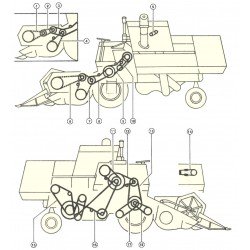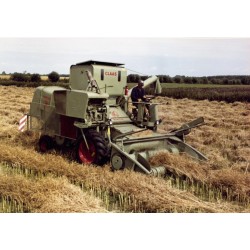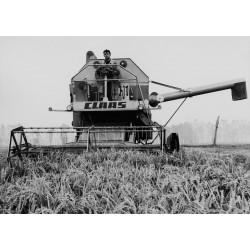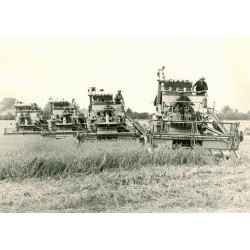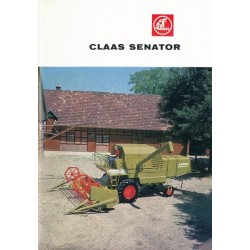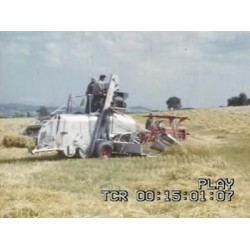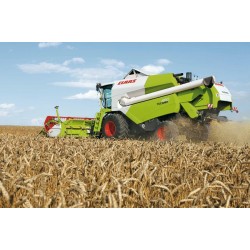Katalog
Biblioteka
-
Combine harvester CLAAS MATADOR
Combine of gigantic proportions (1961-1969)Combine harvester CLAAS MATADOR Together with production of large-sized, high-powered combines an epoch of rationalization began in farming industry. By launching two models Matador-Standard and Gigant combines “Claas” company followed the era of large-sized combines. In that time the Matador with 6 m effective width of reaping-machine seemed really...
Artykuł -
Combine harvester CLAAS MEDION 310-340
Profitability, flexibility, universality (2000-2009)Combine harvester CLAAS MEDION 310-340 The Medion series became the heiress of the Dominator series with traditional system of the threshing mechanism. The Claas Medion 310-340 combines gave a good account of themselves all over the world, because under any harvesting conditions the components are arranged into highly productive machine, that breaks all...
Artykuł -
Combine harvester CLAAS MEGA 202 - 218
More power thanks to APS (1994-2003)Combine harvester CLAAS MEGA 202 - 218 In a series of Mega combines the Claas company implemented APS threshing system for the first time. Unlike production of other manufacturers, there was an additional accelerating drum in front of the threshing drum in this series, which increased profitability in 30%. In autumn 1993 a new combine generation of Mega...
Artykuł -
Combine harvester CLAAS MEGA 350 - 370
Profitability, functionality, universality (2003-2008)Combine harvester CLAAS MEGA 350 - 370 The Mega 350-370 combine harvesters meet all needs of the machinery of such level. These combines are high-powered, possessing high universality while minimal service, which is important criteria of their profitability. The reaping-machine of these combines have installation of “Auto Contour” electrohydraulic...
Artykuł -
Combine harvester CLAAS MERCATOR
Self-propelled combines (1967-1982)Combine harvester CLAAS MERCATOR In 1966 the Senator combine was presented, which was even more large-sized than Matador Gigant, and also had modern design and colour. In a year the Mercator combine was introduced, and the Senator was its prototype. The Protector combine was a simplified model of the Mercator. These combines were fitted with 4 and...
Artykuł -
Combine harvester CLAAS MERCUR
A series of combines for small and average farms (1962-1968)Combine harvester CLAAS MERCUR The launch of this series combines was aimed at meeting widespread needs of small and average farms. “Personal combine to every farmer!” – was a motto of “Claas” company. In 1958 Europa combine was presented (it had 80 cm threshing drum), a in a year – Columbus combine. The horizontal grasp of reaping-machine in Columbus...
Artykuł -
Combine harvester CLAAS PROTECTOR
Self-propelled combines (1968-1981)Combine harvester CLAAS PROTECTOR The modern industrial form defines also the type of combine. With the launch of Senator model “Claas” company provides its combines with new design and typical light green colour. In 1966 the Senator combine was presented, which was even more large-sized than Matador Gigant, and also had modern design and colour. In a...
Artykuł -
Combine harvester CLAAS SELBSTFAHRER (SF)
The first self-propelled combine harvester (1953-1963)Combine harvester CLAAS SELBSTFAHRER (SF) With production of the highly successful trailed combine harvester SUPER still under way, CLAAS set about developing a self-propelled combine harvester to add to its lineup. On 15 December 1952 in dedication to August Claas’ 65th birthday the first self-propelled combine harvester was presented, its name was...
Artykuł -
Combine harvester CLAAS SENATOR
Self-propelled combines (1966-1972)Combine harvester CLAAS SENATOR The modern industrial form defines also the type of combine. With the launch of Senator model “Claas” company provides its combines with new design and typical light green colour. In 1966 the Senator combine was presented, which was even more large-sized than Matador Gigant, and also had modern design and colour. In a...
Artykuł -
Combine harvester CLAAS SUPER
Combine harvester with the L-shaped flow of weight (1946-1978)Combine harvester CLAAS SUPER The mower-thresher-binder with its cross-flow principle soon reached the limits of its performance. As early as 1942, CLAAS engineers pressed ahead with the development of a combine harvester based on the cross-longitudinal flow system, in which the grain is threshed in the cross flow and delivered from the machine in the...
Artykuł -
Combine harvester CLAAS TUCANO 320-450
Effective distribution of straw with minimal fuel consumptionCombine harvester CLAAS TUCANO 320-450 The Tucano combine of this series was presented in autumn 2007. It became a successor of the Medion and Mega combines series. The Tucano is ideal for harvesting of any crops owing to Multicrop system, which has proved its high trust status. In its threshing machine the specialists managed to wrap the main concave...
Artykuł -
Combine harvester FORTSCHRITT E171,...
General information about the development fo the combineCombine harvester FORTSCHRITT E171 - E177 Production of harvest combines in the territory of German democratic republic (East Germany) began with technical assistance of the Soviet Union. The S-4 model (Stalinets) was taken for a basis. A manufacturing started in 1948. The combine was equipped with a 4-meter heder and 6-cylinder petrol engine. Then...
Artykuł

